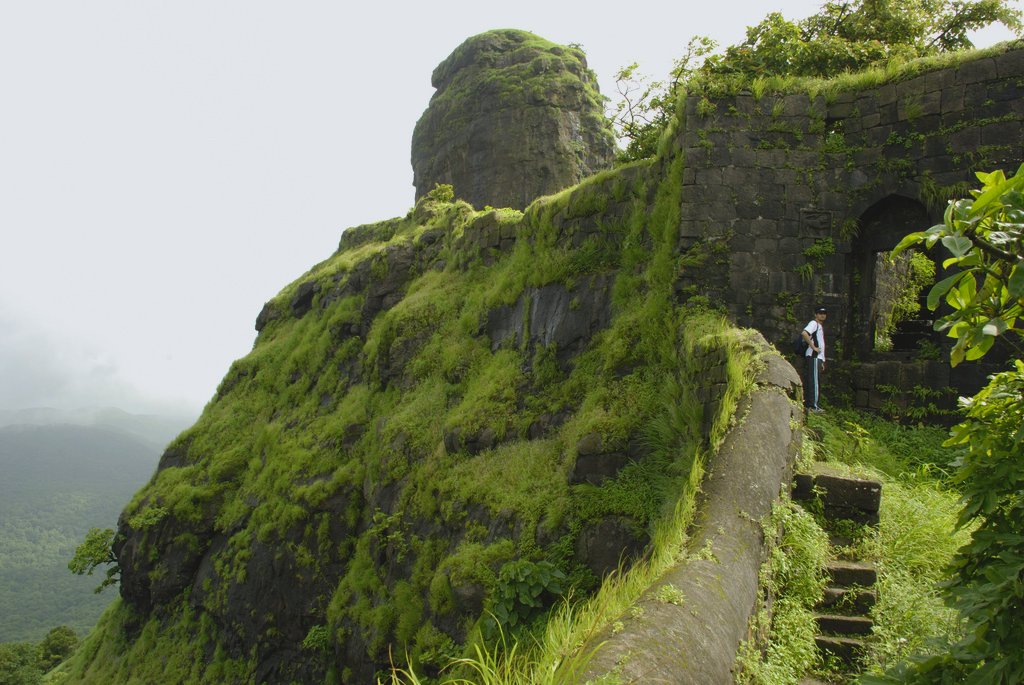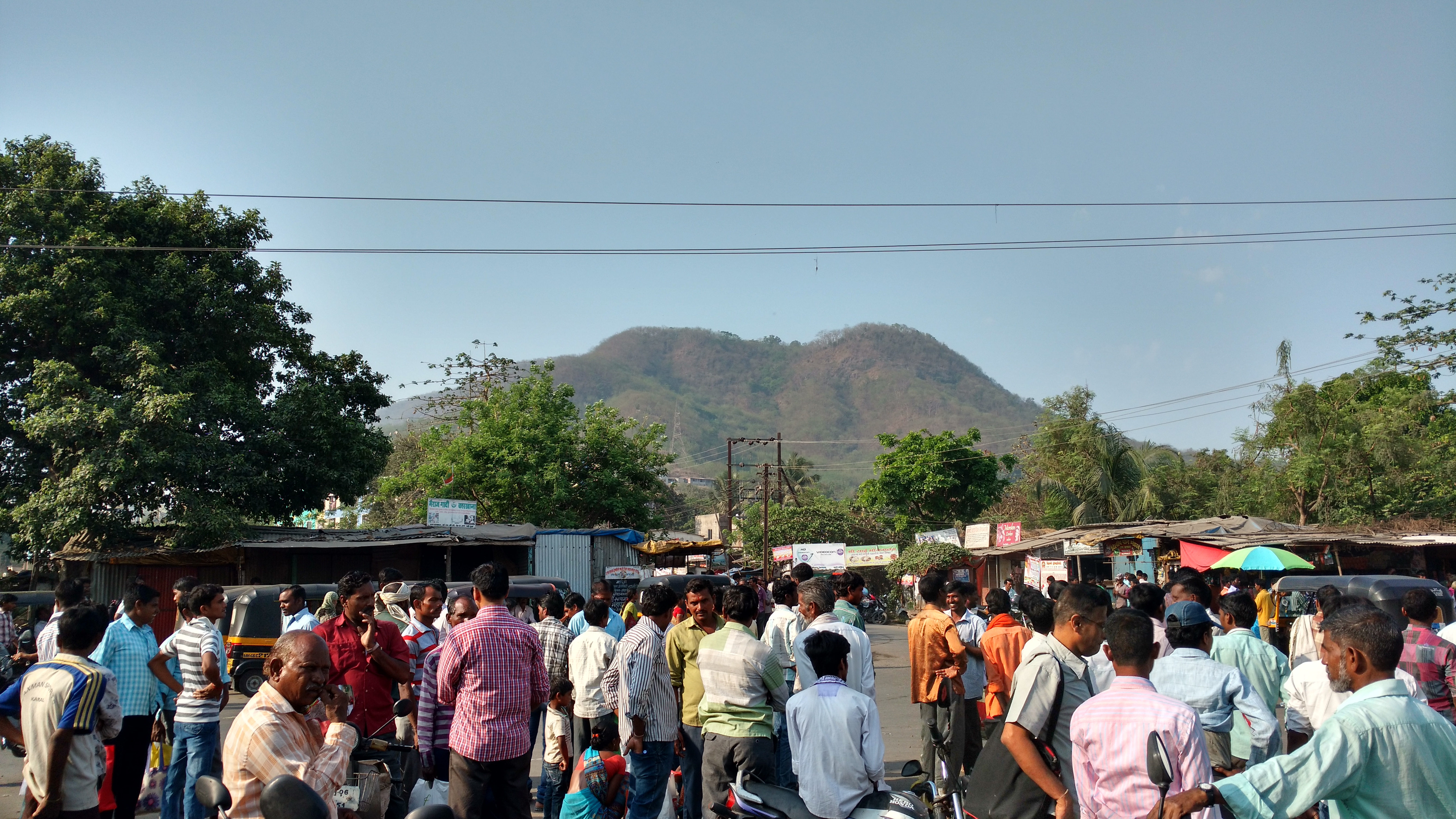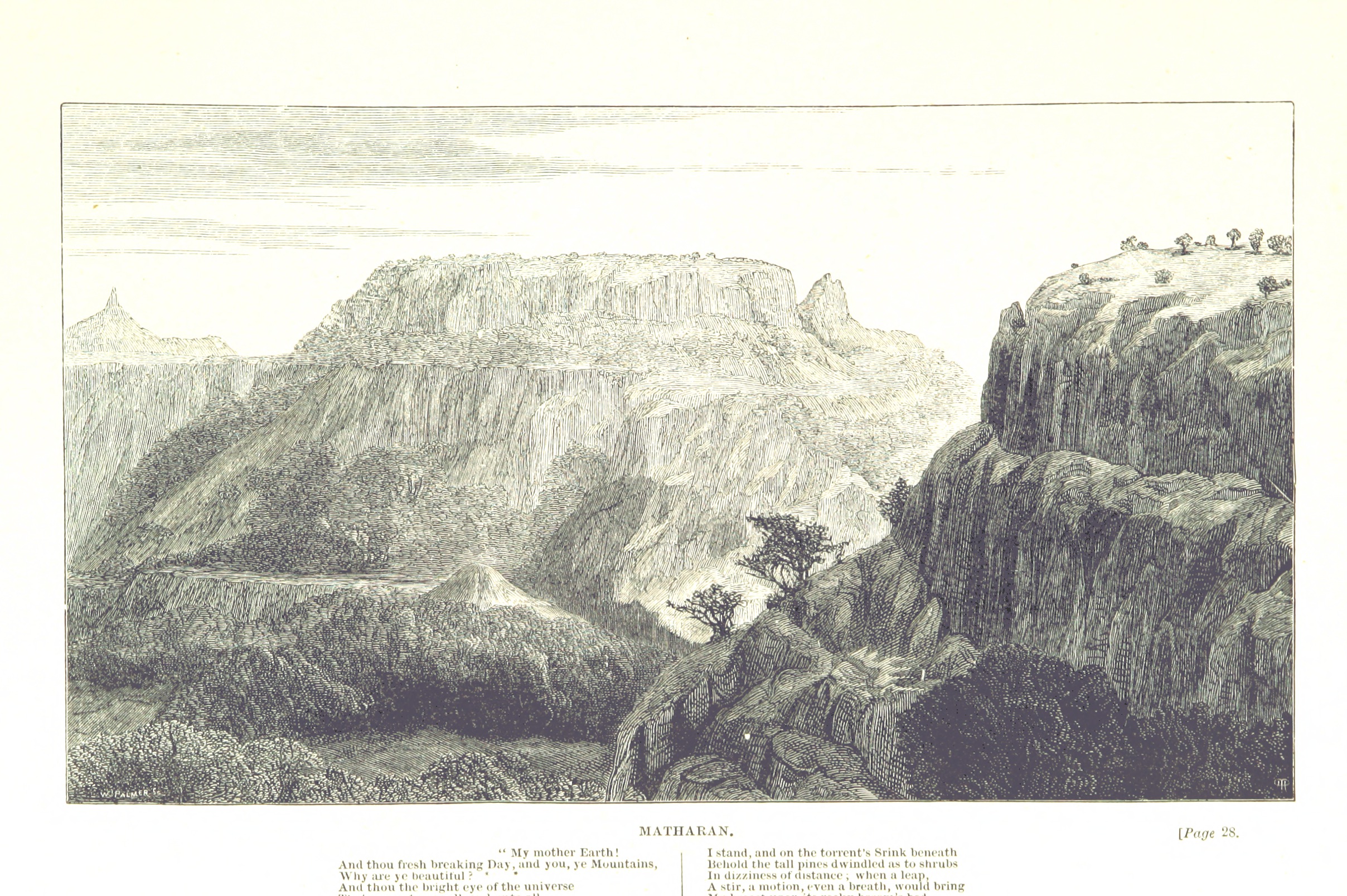|
Karnala Fort
Karnala Fort (also called ''Funnel Hill'') is a hill fort in Raigad district, Maharashtra, India, about 10 km from Panvel city. Currently it is a protected place lying within the Karnala Bird Sanctuary. It was a place of strategic importance since it overlooked the Bor pass, which connected the Konkan coast to the interior of Maharashtra (Deccan Plateau) on the main trade route between these areas. History The fort was likely constructed before 1400, under Devagiri Yadavs(1248–1318) and the Tughlaq rulers (1318–1347), Karnala was the capital of the north Konkan districts of their respective empires. It later fell under the command of the Gujarat Sultanate but in 1540 was taken over by Nizam Shah of Ahmednagar. The Gujarat sultans then requested the help of the Dom Francisco de Menenzes the commanding officer of the Portuguese at Bassien (modern day Vasai) to win it back. He ordered 500 of his soldiers to Karnala fort and they were able to capture it. The fort was ... [...More Info...] [...Related Items...] OR: [Wikipedia] [Google] [Baidu] |
Maharashtra
Maharashtra (; , abbr. MH or Maha) is a states and union territories of India, state in the western India, western peninsular region of India occupying a substantial portion of the Deccan Plateau. Maharashtra is the List of states and union territories of India by population, second-most populous state in India and the second-most populous country subdivision globally. It was formed on 1 May 1960 by splitting the bilingual Bombay State, which had existed since 1956, into majority Marathi language, Marathi-speaking Maharashtra and Gujarati language, Gujarati-speaking Gujarat. Maharashtra is home to the Marathi people, the predominant ethno-linguistic group, who speak the Marathi language, Marathi language, the official language of the state. The state is divided into 6 Divisions of Maharashtra, divisions and 36 List of districts of Maharashtra, districts, with the state capital being Mumbai, the List of million-plus urban agglomerations in India, most populous urban area in India ... [...More Info...] [...Related Items...] OR: [Wikipedia] [Google] [Baidu] |
Shivaji
Shivaji Bhonsale I (; 19 February 1630 – 3 April 1680), also referred to as Chhatrapati Shivaji Maharaj, was an Indian ruler and a member of the Bhonsle Maratha clan. Shivaji carved out his own independent kingdom from the declining Adilshahi sultanate of Bijapur which formed the genesis of the Maratha Empire. In 1674, he was formally crowned the ''Chhatrapati'' of his realm at Raigad Fort. Over the course of his life, Shivaji engaged in both alliances and hostilities with the Mughal Empire, the Sultanate of Golkonda, Sultanate of Bijapur and the European colonial powers. Shivaji's military forces expanded the Maratha sphere of influence, capturing and building forts, and forming a Maratha navy. Shivaji established a competent and progressive civil rule with well-structured administrative organisations. He revived ancient Hindu political traditions, court conventions and promoted the usage of the Marathi and Sanskrit languages, replacing Persian in court and administratio ... [...More Info...] [...Related Items...] OR: [Wikipedia] [Google] [Baidu] |
Dronagiri Fort
Dronagiri Fort is a fort in Navi Mumbai's Raigad district, Maharashtra, India. Introduction The fort is situated on the top of the hill which is close to Uran town in Raigad district. The fort is accessible in all seasons. The trek to the fort is simple and safe. Being close to Uran and Karanja, the fort was strategic importance since old times. The entire hill is densely covered with forest. History The fort was under the rule of Yadav of Devgiri. In 1530 The fort was repaired by the Portuguese. In 1535 the father Antono-de-porto constructed three churches Nosa senhora, N.S.Da Penha and Sam Francisco. In 16th century the fort was captured by Adilshah and was in his control for some period. Finally it passed to the hand of British. On 10 March 1739 the fort was captured by Manaji Angre along with the Uran (Daurnagar) fort Places to see The ruins of the fortification are seen on the fort. There is a church Nossa Senhora da Penha in good condition, but without any idol or in ... [...More Info...] [...Related Items...] OR: [Wikipedia] [Google] [Baidu] |
Sankshi Fort
Sankshi Fort सांक्शी किल्ला This fort is located in Pen Taluka of Raigad district of Maharashtra. It is from Pen. History A Sank king built the fort. He had a daughter named Jagamata. The king was killed in battle, his daughter committed suicide by jumping from the fort; this is the popular myth. In 1540 Nizamshah of Ahmednagar captured this fort from Gujarath's sultan. The Sultan of Gujarat captured it back with the help of Portuguese. Later he assumed the Nizam were counter-attacking the fort, so he handed over the fort to the Portuguese and ran away to Gujarat. Due to frequent attacks on the army by the Nizam, the Portuguese purchased the fort along with Karnala fort from Nizam. Places of interest There are no Bastions or Gate on the fort. But there are plenty of rock cut cisterns on the fort and a small cave. Climbing the fort is through rugged, rough rocky boulders. The Badruddin Darga at the base of the fort is worth visiting. There is a water ... [...More Info...] [...Related Items...] OR: [Wikipedia] [Google] [Baidu] |
Matheran
Matheran is an automobile-free hill station and a municipal council in the Karjat taluka of the Raigad district located in the Indian state of Maharashtra. Matheran is part of the Mumbai Metropolitan Region, and one of the smallest hill stations in India. It is located in the Western Ghats, at an elevation of around 800 m (2,625 feet) above sea level. It is about 90 km from Mumbai, and 120 km from Pune. This proximity to these urban areas makes it a weekend getaway for many. Matheran, which means "forest on the forehead" (of the mountains) in Marathi, is an eco-sensitive region, declared by the Ministry of Environment, Forest and Climate Change, Government of India. It is Asia's only automobile-free hill station. There are many hotels and Parsi bungalows in the area. Old British colonial architecture is preserved in Matheran. The roads are made of red laterite earth. History Matheran was identified by Hugh Poyntz Malet, the then district collector of Raig ... [...More Info...] [...Related Items...] OR: [Wikipedia] [Google] [Baidu] |
Chanderi Fort
Chanderi Fort located at Chanderi in Ashoknagar District of Madhya Pradesh state in India is situated at a distance of 127 km from Shivpuri and 37 km from Lalitpur and about 45 km from Esagarh and 38 km from Mungoali It is located on a hill southwest of the Betwa River. Chanderi is surrounded by hills, lakes and forests and there are several monuments. Chanderi finds mention in Mahabharata. Shishupal was the king of Mahabharata period. Chanderi is located strategically on the borders of Malwa and Bundelkhand. History of Chanderi goes back to the 11th century, when it was dominated by the trade routes of Central India and was proximate to the arterial route to the ancient ports of Gujarat as well as to Malwa, Mewar, Central India and the Deccan. Consequently, Chanderi became an important military outpost. Chanderi Fort, a vast Mughal fort, dominates the skyline of the lovely old town of Chanderi. The main gate of the fort is known as the "Khooni Darwaza". ... [...More Info...] [...Related Items...] OR: [Wikipedia] [Google] [Baidu] |
Manikgad
Manikgad / (also called Gadchandur) ( mr, माणिकगड / गडचांदूर ) is an ancient fort in Chandrapur district, Maharashtra. It is a hill fort 507 metres above sea level built by the Naga kings in 9 CE. The fort is in ruins and is frequented by wild animals that live in the vicinity, such as panthers and boars The wild boar (''Sus scrofa''), also known as the wild swine, common wild pig, Eurasian wild pig, or simply wild pig, is a suid native to much of Eurasia and North Africa, and has been introduced to the Americas and Oceania. The species is n .... Several monuments of historical importance are nearby. History Manikgad was built by the last Mana Naga King - Gahilu. The Mana Nagas settled in this area around 9 CE. Initially, the fort was named Manikagad after the patron deity of the Mana Nagas - Manikadevi - but later on this was shortened to Manikgad. Local legend holds that the fort was built by a Gond king named Mankyal (hence the ... [...More Info...] [...Related Items...] OR: [Wikipedia] [Google] [Baidu] |
Prabalgad
Prabalgad (also known as Muranjan, Pradhangad or Prabalmachi) is a fort located between Matheran and Panvel and comes under the Raigad District in the state of Maharashtra, India. The Prabalgad Fort stands at an elevation of in the Western Ghats. The fort was previously known as ''Muranjan'' until it was taken over and renamed by the Maratha forces under Chatrapati Shivaji's rule. Its sister fort is Irshalgad. Right next to Prabalgad, to its north, lies the steep Kalavantin pinnacle. History The Prabalgad Fort was built by the Bahmani Sultanate to keep an eye on the Panvel Fort and the Kalyan Fort in the North Konkan area. Around 1458 A.D, "Malik Ahmad" the prime minister of the kingdom of Ahmednagar, took over the fort during his conquest of Konkan. After disintegration of the Bahmani Sultanate, the fort remained with the Ahmadnagar Sultanate. During the collapse of the Ahmadnagar Sultanate, Shahaji led a helping hand against the separate forces of the Mughal Empire ... [...More Info...] [...Related Items...] OR: [Wikipedia] [Google] [Baidu] |
Karnala Fort Bastion , a fort in Maharashtra
{{disambiguation ...
Karnala may refer to: *Karnala Bird Sanctuary, a bird sanctuary in Maharashtra *Karnala fort Karnala Fort (also called ''Funnel Hill'') is a hill fort in Raigad district, Maharashtra, India, about 10 km from Panvel city. Currently it is a protected place lying within the Karnala Bird Sanctuary. It was a place of strategic importan ... [...More Info...] [...Related Items...] OR: [Wikipedia] [Google] [Baidu] |
Peshwas
The Peshwa (Pronunciation: e(ː)ʃʋaː was the appointed (later becoming hereditary) prime minister of the Maratha Empire of the Indian subcontinent. Originally, the Peshwas served as subordinates to the Chhatrapati (the Maratha king); later, under the Bhat family, they became the ''de facto'' leaders of the Maratha Confederacy, with the Chhatrapati becoming a nominal ruler. During the last years of the Maratha Empire, the Peshwas themselves were reduced to titular leaders, and remained under the authority of the Maratha nobles and the British East India Company. All Peshwas during the rule of Shivaji, Sambhaji and Rajaram belonged to Deshastha Brahmin community. The first Peshwa was Moropant Pingle, who was appointed as the head of the Ashta Pradhan (council of eight ministers) by Chhatrapati Shivaji Maharaj, the founder of the Maratha Empire. The initial Peshwas were all ministers who served as the chief executives to the king. The later Peshwas held the highest administra ... [...More Info...] [...Related Items...] OR: [Wikipedia] [Google] [Baidu] |
Aurangzeb
Muhi al-Din Muhammad (; – 3 March 1707), commonly known as ( fa, , lit=Ornament of the Throne) and by his regnal title Alamgir ( fa, , translit=ʿĀlamgīr, lit=Conqueror of the World), was the sixth emperor of the Mughal Empire, ruling from July 1658 until his death in 1707. Under his emperorship, the Mughals reached their greatest extent with their territory spanning nearly the entirety of South Asia. Widely considered to be the last effective Mughal ruler, Aurangzeb compiled the Fatawa 'Alamgiri and was amongst the few monarchs to have fully established Sharia and Islamic economics throughout South Asia.Catherine Blanshard Asher, (1992"Architecture of Mughal India – Part 1" Cambridge university Press, Volume 1, Page 252. Belonging to the aristocratic Timurid dynasty, Aurangzeb's early life was occupied with pious pursuits. He held administrative and military posts under his father Shah Jahan () and gained recognition as an accomplished military commander. Aurang ... [...More Info...] [...Related Items...] OR: [Wikipedia] [Google] [Baidu] |
Breastworks
A breastwork is a temporary fortification, often an earthwork thrown up to breast height to provide protection to defenders firing over it from a standing position. A more permanent structure, normally in stone, would be described as a parapet or the battlement of a castle wall. In warships, a breastwork is the armored superstructure in the ship that did not extend all the way out to the sides of the ship. It was generally only used in ironclad turret ships designed between 1865 and 1880. See also * List of established military terms (Fortifications A fortification is a military construction or building designed for the defense of territories in warfare, and is also used to establish rule in a region during peacetime. The term is derived from Latin ''fortis'' ("strong") and ''facere'' ...) Fortifications by type {{Fort-stub ... [...More Info...] [...Related Items...] OR: [Wikipedia] [Google] [Baidu] |






